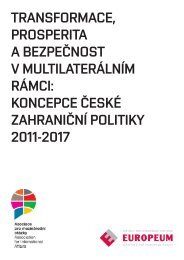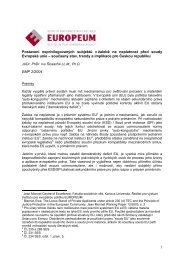eu constitutionalisation - EUROPEUM Institute for European Policy
eu constitutionalisation - EUROPEUM Institute for European Policy
eu constitutionalisation - EUROPEUM Institute for European Policy
Create successful ePaper yourself
Turn your PDF publications into a flip-book with our unique Google optimized e-Paper software.
Chapter 6: A ‘saut constitutionnel’ out of an intergovernmental trap?SUMMARY: 11 THESES1) Given the “DDS syndrome” (discreet and discretionary action, highlyloaded with sovereignty symbols) the <strong>constitutionalisation</strong> of <strong>for</strong>eign, securityand defence policy raised and raises specific demands and challengesboth <strong>for</strong> the constitutional architects as <strong>for</strong> the academic observers.Anatomy and analysis: trends and innovations2) Despite extensive re<strong>for</strong>mulation, major provisions document containa high degree of continuity:a) an unclear and diffuse division of Union and member state competences:keeping it as a sui generis categoryb) in spite of the birth of legal personality: an ongoing life of the <strong>for</strong>merpillar structure in terms of the designed procedures;c) limited extension of the Union’s resources and instruments: nosupranational upgradingd) soft obligations <strong>for</strong> cooperation rules among member states: constitutionalprose without sanctions;e) a reconfirmation of decision-making rules: indefinite veto rights.f) extension and strengthening of the <strong>European</strong> Council: constitutionalisingthe de facto role.3) The text sets ambitious expectations upgrading a mixture of civilianpower with (limited) military interventionism towards some kind ofstate like qualities of a global actor.4) The institutional provisions will lead to a high degree of personalisationand politicisation as well as to intensive inter- and intra-institutionalpower struggles:a) The UMFA will improve the external visibility but the role assignmentsare not matched by respective internal powers.b) The ambiguous profile <strong>for</strong> fulltime <strong>European</strong> Council Chair willlead to major conflicts with the Union Minister <strong>for</strong> Foreign Affairs(UMFA) and the President of the Commission.5) The procedural provisions <strong>for</strong> new <strong>for</strong>ms of flexibility do not offer sufficientincentives <strong>for</strong> mobilising military resources.198Chapter 6: A ‘saut constitutionnel’ out of an intergovernmental trap?Assessment6) The masters of the constitutional treaty have not achieved a constitutionalbreakthrough, but moved even more into the intergovernmental trap.7) The capability-expectations gap has been widened.Next constitutional steps8) In cases of high politics, the new provisions will not improve the per<strong>for</strong>manceof the EU as a global actor.9) By staying within the intergovernmental trap the new provisions haveconfirmed the in-built need <strong>for</strong> further re<strong>for</strong>ms.10) In line with a negative scenario of non-ratification of the constitutionaltreaty (TCE), major institutional weaknesses of the CFSP wouldpersist; however, especially with regard to ESDP, some elements ofthe TCE have already been or could be implemented on the basis ofsecondary law.11) After the next crisis, we expect further steps in a process of ratchetfusion towards a new plateau.1. THE CHALLENGE:ANALYSIS AND ASSESSMENT OFA CONSTITUTIONAL CORNERSTONE 1Since the early days of the <strong>European</strong> integration process,² it has been oneof the fundamental motivations <strong>for</strong> any construction plan to strengthenthe role of Europe as a global actor. Public opinion all over the Union hascontinuously asked <strong>for</strong> an active role of the EU in the international system³.The constitutional and especially institutional architecture of the “CommonForeign and Security <strong>Policy</strong> (CFSP)” is thus a cornerstone in the “Treatyestablishing a Constitution <strong>for</strong> Europe” (hereafter TCE or ‘constitutionaltreaty’) which the “Convention <strong>for</strong> the Future of Europe” presented to the1) An earlier version of this chapter was presented at the Conference “Altn<strong>eu</strong>land: The Constitution of Europein an American Perspective” (New York, April 2004).2) See e.g. Spinelli, Il manifesto di Ventotene; Robert Schuman declaration, in: LIPGENS (1985), pp. 71,193-194.3) See e.g. Eurobarometer 2004; NIEDERMAYER (2003), pp. 52-53.199








